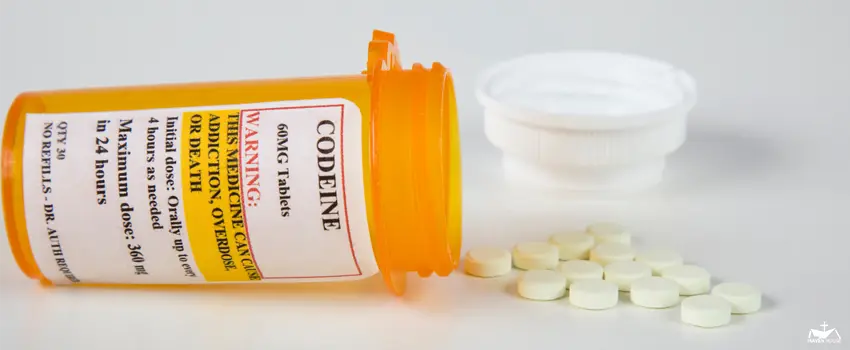

Table of Contents
Medicinal drugs can help individuals manage pain, alleviate symptoms of illness or disease, and improve overall health and well-being. However, humans tend to develop dependence on these drugs, leading to addiction and potentially harmful consequences.
Addiction to medicinal drugs, such as codeine and co-codamol, is a growing problem worldwide and can have severe consequences for an individual’s physical and mental health. Read on to learn more about co-codamol and its effects on the body.
What is co-codamol?
Co-Codamol is a painkiller that contains a combination of two active ingredients: codeine, an opioid pain reliever, and paracetamol, a non-opioid pain reliever. Together, these two substances alleviate pain and reduce fever by blocking pain signals in the brain and reducing inflammation throughout the body.
While co-codamol can be an effective pain relief medication, also has the potential for addiction when mixed with alcohol and other drugs. Learn more about this medication by reading some of the most asked co-codamol FAQs below:
1. Can you buy co-codamol over the counter?
This medication comes in three different strengths: 8mg, 15mg, and 30mg–all of which containing 500mg of paracetamol. While, it’s possible buy the lowest dosage of co-codamol without prescription at pharmacies, higher strengths would require a doctor’s prescription.
2. Can co-codamol make you high?
When taken in more significant amounts than prescribed or used for recreational purposes, co-codamol can produce euphoria or a “high” sensation. However, taking too much of this medication can lead to serious side effects.
3. What are co-codamol’s side effects?
Like other drugs, co-codamol causes side effects if taken more than the prescribed dosage. Co-codamol side effects vary in severity. The common side-effects include the following:
- Drowsiness
- Dry Mouth
- Constipation
- Dizziness
- Nausea
There are also severe side effects that can appear to individuals who abuse co-codamol. These symptoms include:
- Addiction
- Allergic Reactions
- Difficulty Breathing
- Liver Damage
Speaking to a doctor or pharmacist is crucial if you experience any co-codamol side effects or are concerned about its use.
Dangers and Risks of Co-Codamol Abuse
Abusing co-codamol can pose significant dangers and health risks to individuals. As the body builds a tolerance to co-codamol over time, higher doses are required to achieve the same level of pain relief, leading to an escalating cycle of use and potentially fatal overdose.
Taking co-codamol in higher dosage and prolonged usage can cause the following health problems:
1. Co-Codamol Overdose
Taking too much co-codamol can cause overdose that have various symptoms, including confusion, dizziness, nausea, vomiting, constipation, respiratory depression, and unconsciousness.
In severe cases, co-codamol overdose can lead to respiratory failure, coma, and even death. Co-Codamol mixed with other drugs like benzodiazepines increases the risk of overdose.
2. Co-Codamol Addiction
Co-codamol is a highly addictive medication and should only be used as a last resort for pain relief. It is crucial to understand that any strength of co-codamol has the potential to lead to opiate dependence and addiction, not just prescription strength.
Over time, the brain can become dependent on the drug’s effects, leading to intense cravings and withdrawal symptoms when use is stopped or reduced.
Here are some typical signs of co-codamol addiction to watch out for:
- Slurred Speech
- Clumsiness
- Shallow Breathing
- Loss of Appetite
- Depression
- Defensiveness and Poor Anger Management
- Decreased Productivity
It’s best to avoid taking co-codamol if you already have a history of drugs or alcohol abuse. If you’re still in pain and need more dosage, consult your doctor before buying and taking a new batch.
How To Treat Co-codamol Addiction
If you or a loved one is struggling with addiction, it’s essential to seek help as soon as possible. Addiction is a complex and challenging disease that often requires professional treatment. Here are several options available:
1. Co-codamol Detox
Attempting to detox from co-codamol without medical supervision can be dangerous and even life-threatening. It’s crucial to seek professional help and guidance from a medical team or addiction treatment center.
The detox process usually involves gradually tapering off the dose of co-codamol over time, which can help minimize the severity of withdrawal symptoms. Medical professionals may also administer medications to alleviate withdrawal symptoms such as nausea, anxiety, and insomnia during detox.
2. Rehabilitation
After detox, it’s crucial to get ongoing addiction treatment, such as therapy or rehabilitation, to maintain sobriety and prevent relapse. Going to rehabilitation centers can help addicts identify the underlying issues that led to addiction and learn new healthier coping skills for maintaining sobriety. Most rehabilitation centers offer a wide variety of programs and therapy like cognitive behavioral therapy, which is an effective way to treat addiction.
Key Takeaway
Co-codamol addiction is a severe issue that can severely affect an individual’s health, relationships, and overall quality of life. For a safe and effective recovery, it’s best to seek professional help and guidance.
Treatment options may include detox, rehabilitation, therapy, and ongoing support through support groups or aftercare programs. With the proper support and commitment to recovery, overcoming co-codamol addiction and living a healthy, fulfilling life free from the grip of addiction is possible.
Take the first step in co-codamol addiction recovery at Haven House Recovery!
Haven House Recovery is here to assist and guide you or your loved one in their co-codamol addiction recovery. We offer a wide variety of programs that cater for improving the lifestyle and habits of recovering addicts. Our dedication to helping individuals succeed in bettering themselves is what makes us one of the most trusted rehabs for addiction recovery in Tennessee.
Newsletter Signup
Discipleship Training
“The teaching of the wise is a Fountain of Life, turning a person from the snares of death.”
Proverbs 13:14 NIV




